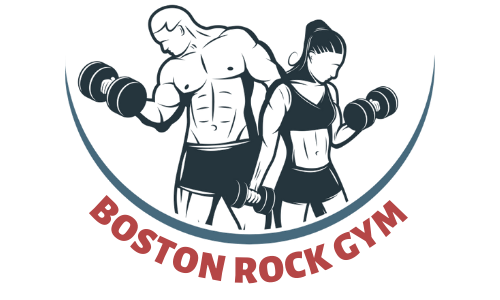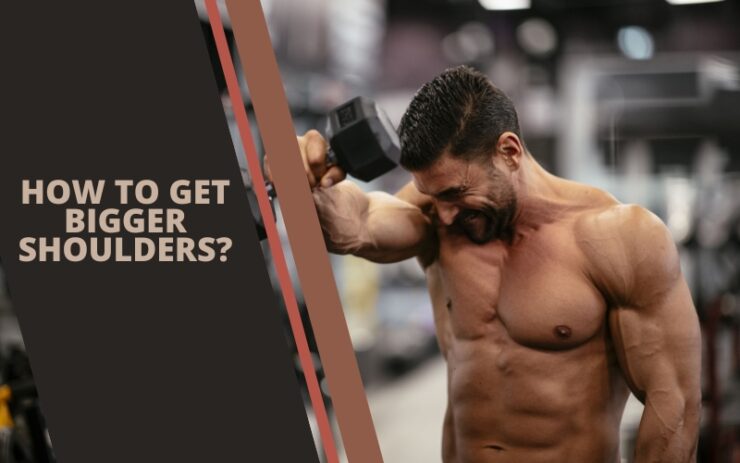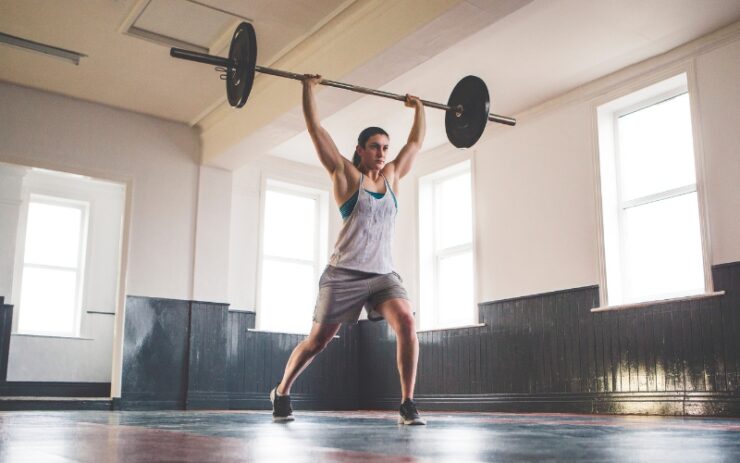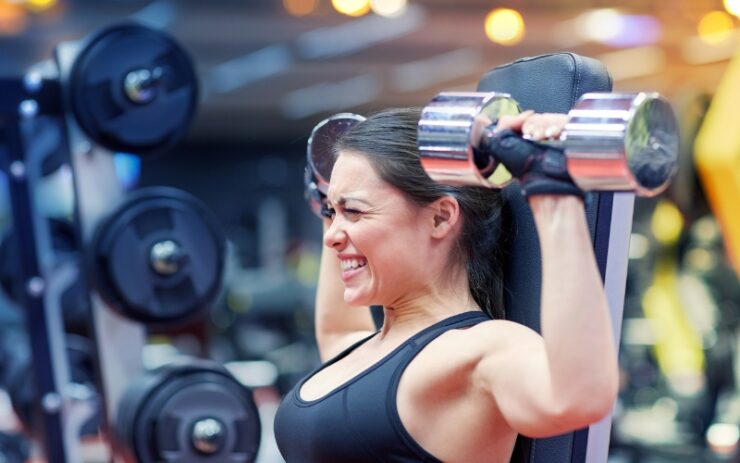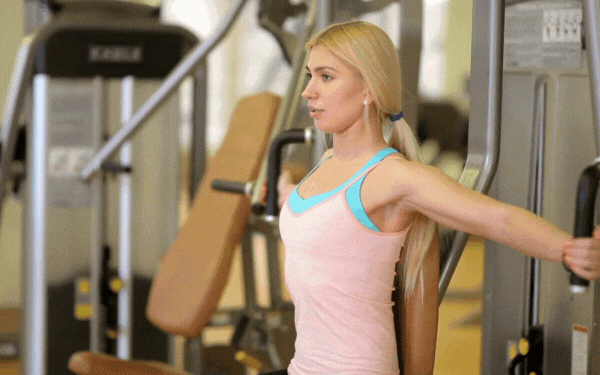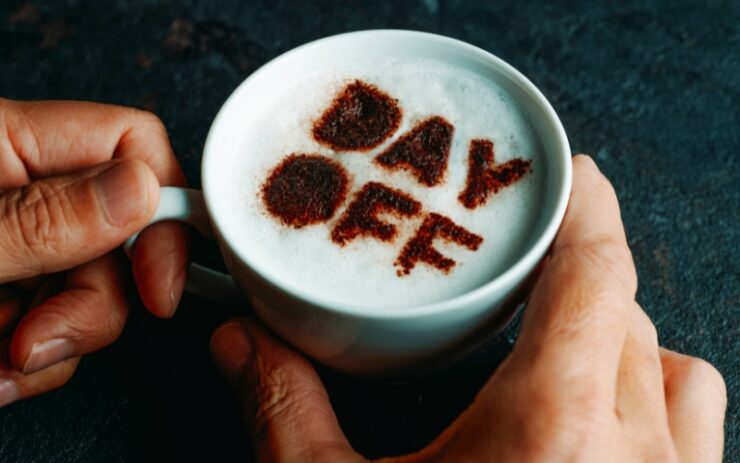Getting big shoulders doesn’t have to be a nightmare! With our guide that contains step-by-step exercises, as well as the tips and tricks we prepared for you, you’ll be able to get bigger shoulders in a snap! Let’s dive right into it.
Contents
Top 8 Exercises To Get Bigger Shoulders
1. Standing Overhead Press
One of the most popular shoulder workouts is the overhead press. Standing up, you push a barbell or a few dumbbells overhead. The fact that so many muscles are needed to complete this exercise accounts for its popularity. You don’t merely use your deltoids to lift the weight overhead.
In order to stabilize yourself, you also use a number of additional muscles from other parts of your body. Your core, in particular, becomes highly involved. This indicates that it’s an effective workout for improving total body conditioning. Here’s how to do this exercise:
- Start by standing with your feet shoulder-width apart and your abs tight
- Make sure your wrists are precisely above your elbows in a straight line as you hold the barbell or dumbbells in your hands at shoulder height
- Push the weight up and avoid arching your back as you do so
- Under control, revert to the original position and repeat
2. Seated Dumbbell Press
An alternative to the overhead press that is done while seated is the seated dumbbell press. This exercise is more effective at especially targeting the deltoids. Your core doesn’t have to work as hard to stabilize you because you are seated.
More of the burden will fall on your shoulders. This implies that while you won’t be able to lift as much weight when doing a seated dumbbell press as opposed to a standing one, it does aid in specifically targeting deltoid muscle mass growth. The seated dumbbell shoulder press is performed as follows:
- Begin by bracing your core while sitting with your feet flat on the floor
- In a straight line, hold the dumbbells at shoulder height with your wrists directly over your elbows
- Push the weight up and avoid arching your back as you do so
- Under control, revert to the original position and repeat
3. Rear Deltoid Fly
The rear deltoid fly, as its name implies, targets the area of your deltoids closest to the back of your shoulders. Since it works the back as well as other important muscle groups in this area of the body, some people prefer to undertake this exercise.
You can use both arms at once or just one to do the rear delt fly. The latter is significantly more difficult. Comparatively to the presses, you may anticipate lifting less weight with this workout. You can do this exercise by following the next steps:
- Beginning in a sitting posture, bend your upper body forward until your chest is nearly parallel to the floor
- Start by grasping the dumbbells with your arms stretched downward and toward the floor
- Pull back your shoulder blades, bend your elbows just a little, and lift the dumbbells into a T-shape with your body
- Under control, revert to the original position and repeat
4. Frontal Raise
The anterior deltoids, or frontal shoulder muscles, are the focus of the frontal raise. This exercise also recruits the core because it is done while standing. To maintain your balance and assist in building the momentum required to bring the dumbbells to shoulder height, engage your core. Follow these steps to do the frontal raise properly:
- Start by standing with your feet shoulder-width apart, your knees slightly bent, and your abs tightened
- Point your shoulder blades downward
- Raise both dumbbells straight up in front of the body while maintaining a small bend in the elbow
- Under control, revert to the original position and repeat
5. Lateral Raise
Similar to the frontal raise, the lateral raise requires lifting the dumbbells to the side of the body instead of out in front, as you can probably assume.
In contrast to the frontal raise, the lateral raise works a different area of the deltoid. The lateral raise especially works the medial deltoids, the side portion of the shoulder muscle. Here’s how to perform it:
- With your feet hip-width apart, adopt a tall posture while holding a dumbbell in each hand
- Keep your shoulders slightly externally rotated while bending forward at the waist to tilt your body forward
- Keep your elbows slightly bent and inhale to contract your abdominal muscles
- Exhale as you bring the dumbbells out to your sides until they are almost parallel to your shoulders
- Under control, revert to the original position and repeat
6. Upright Row
A barbell or dumbbell is pulled straight up to the chest during an upright row. Although it is a shoulder workout, the trapezius muscles are also activated. This muscle group is located in the back of the torso, between the shoulders.
When fully developed, the traps are visible at the sides of the neck from the front of the body. They could aid in creating the illusion of wider shoulders.
Depending on how you grasp the bar, the upright row may be employed to stimulate both of these muscular groups to different degrees. The deltoids are put to greater use when you have a broader grasp. The trapezius muscles are put under additional strain when you have a tighter grip. This is how you do an upright row:
- Start by standing with your feet shoulder-width apart, your knees slightly bent, and your abs tightened
- Point your shoulder blades downward and back
- Keep your elbows at or below shoulder height as you straighten the bar or the dumbbells up toward your chest
- Under control, revert to the original position and repeat
7. Reverse Pec Deck
You may concentrate on the mind-muscle connection while isolating the back delts with this exercise. The specific movement that the rear delts are in charge of is fulfilled by the reverse pec deck. Compared to other rowing variants, it causes the greatest activation of the rear delts. The reverse pec deck is performed as follows:
- When gripping the handlebars, adjust the seat so that your arms are at shoulder height.
- Holding the grips as you would for chest flies is improper. Keep your hands relaxed and place them palm down on the inner handle
- Lead with your elbow and press the handles with your pinky fingers while keeping your arms slightly bent
- Until your upper arms are directly pointed at the side of your body, reverse fly
- Return the handles to their initial position
8. Bent-Over Reverse Fly
If you don’t have access to a reverse pec deck, this workout is the next best thing. Holding dumbbells with your back parallel to the floor allows you to simulate a comparable action.
Treat the reverse fly like a calm swinging action to lessen the use of bigger muscles like the rhomboids and traps. This is how:
- Holding some light dumbbells, squat down with your body parallel to or nearly so with soft elbows that are slightly bent
- Instead of moving directly to the side, make a broad arc Y shape as you reverse fly. As you make the motion, turn your thumbs down as if you were pouring two sips from the bottle
Tips on How To Get Bigger Shoulders
Maintain a Healthy Diet
Eat meals that encourage muscle building if you want bigger shoulders. Your ability to gain effects from exercise is limited if you do not consume a healthy diet that helps you grow muscle. You may achieve your goals by concentrating on increasing the amount of protein, complex carbs, and calories in your diet.
Your arms need more calories when they are growing and developing than they do when they are at rest. To do the additional effort of increasing weight, your body requires extra energy and calories.
Work Out With Adequate Volume
A dose-response association exists between training volume and muscle growth. In other words, muscular development increases as you accomplish more sets and repetitions. For the shoulders, you should be aiming for a minimum of 7 sets each week and a maximum of 25 sets.
Include Rest Days
Every time you push for your chest, your front delts and triceps suffer a terrible beating. It makes about as much sense to exercise your legs after an hour of wind sprints as it does to thrash your shoulders the same day as a complete chest program.
Give your shoulders the greatest present in the world—the rest they require—so that you can hit them hard the next time it’s time to work out if you want them to grow. You want to space the chest and shoulders out by at least a day, if not longer.
Conclusion
Now that you know what exercises to do and what type of diet to maintain, all that’s left is to start your daily routine! If you stay on top of the game, you’ll start seeing the desired results in no time! Remember, dedication and consistency are keys to success.
